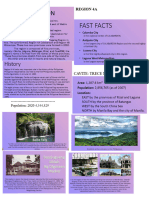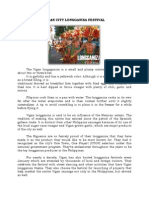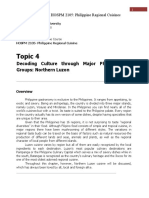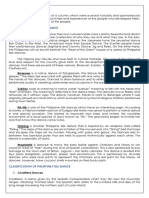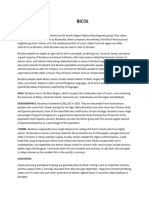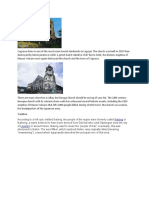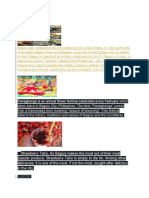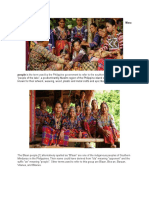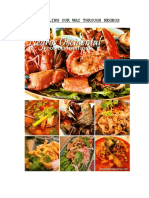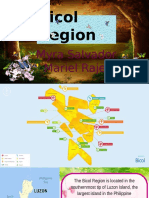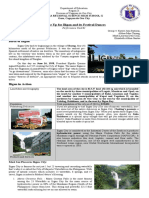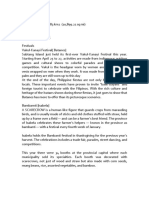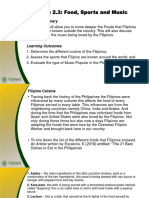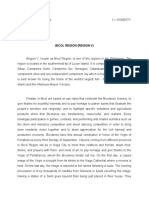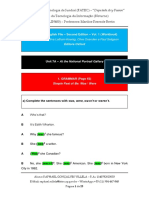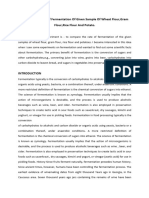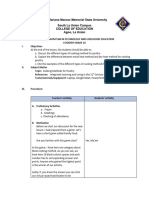Pangalay is a traditional Tausug dance characterized by elaborate body postures and gestures and the
graceful arm and hand movement of the dancer, amplified by the use of janggay or metal claws. The
dance is performed to the music of the kulintangan, gandang, agong and gabang. Commonly referred to
as the fingernail dance.
Ang dahilan kung bakit ang northern mindanao ay known as the largest economy in the island of
mindanao ay dahil sa maraming mga pubrika at industriya ang tumatakbo dito mainly agricultural,
forestry and fishing. Una ay ang Nestlé S.A. it is a Swiss multinational food and drink processing
conglomerate corporation headquartered in Vevey, Vaud, Switzerland. Familiar naman na tayo lahat sa
del monte na focus din sa foods and beverage. Coca cola and cagayan corn production Corp. And
LIMKETKAI MANUFACTURING CORPORATION (LMC) which is among the leading manufacturer of edible
oils and cereals for the retail food service, institutional and export markets. As quality products carry the
well-known brands of Marca Leon, Frito Plus and Twin Wood.
Holcim corporation isa itong cement manufacturer. Ang Philippine Sinter Corp naman produces steel
products or bakal. The Company’s line offers mining, milling, and preparing metal ores.
Pilmico Foods Corporation provides packaged food products. The Company offers flour, poultry and
aqua feeds, and meat products.
Universal Robina Corporation is a Philippine company and. It is one of the largest food and beverage
companies in the Philippines. Ka ilang sa corporation nila ang jack and jill at tanyag ang mga products
gaya ng piatos, C2, great taste white at iba pa.
Asia Brewery, Inc. is a Philippines-based diversified beverage company owned by LT Group, Inc., a
publicly listed holding company of Lucio Tan. Products nila ay gaya ng colt 45,cobra, vitamilk, at mga
tubig gaya ng absolute.
The Talaandig are known to be dwellers of the steep places. They are the people of the slopes (andig).
And ang paniniwala nila na ang concept of balance enables the Talaandig person to determine the
conflict that resulted from the interaction of the positive and negative forces in the environment.
Through the concept of balance the Talaandig is able to achieve peace and harmony or resolve
particular conflicts whenever they exist.
Manobo tribe is culturally rich in traditional practices, medicinal uses, diversity, and traditional
knowledge based on their community plant resources. They dwell in hinterlands and mountainous
�regions in the southern part of the Philippines and live an intricate life dependent on agriculture and
forest plants.
Higaonons are described as the
“people of the living mountains” and “people of the wilderness.” Their name is derived from “higa”
means “to
Live or reside,” “gaon” means “mountain or highland,” and “onon” means “people.” The culture of the
Higaonon tribe can be best described as one of peace, for solving the internal conflicts of other ethnic
groups.
They practice an ancient ritual called Tampudashu Balagun, which means “treaty of the green vine
branch;” means cutting the vine and symbolically, cutting disputes between ethnic groups.
The congenital people called Matigsalug Tribe are famous in terms of weaving, bead making and
patchwork. Matigsalug are the original inhabitants of the Salug River (now called the Davao River).
The Tigwa or Tigwahanons are scattered all over the Municipality of San Fernando in Bukidnon close to
the border of Davao del Norte. The term Tigwahanen may have been derived from guwa (scattered) or
from the Tigwa River where its banks and watersheds are inhabited by the Tigwahanon.These people
have tree houses called batangan built among the branches of a growing tree with the tree trunk as its
solitary post.
The Bukidnons Is an ethnic tribe in North central Mindanao whose ancestors were the aborigines of the
coastal places of what is now the province of Misamis Oriental. Their major means of subsistence are
food gathering and swidden agriculture.
Umayamnon tribe. These Indigenous peoples dwell along the watershed of Umayam River in the
Mountains of Pantaron in the Eastern side of the province of Bukidnon. They are fair in complexion five
feet or above in height. Their eyes are set closed enough to each other with an average height of nose
bridge.
The refreshing cool climate in the Bukidnon plateau is attributed to its fairly high altitude. The
province’s terrain is characterized by deep ravines and dense forest mountains which protect the
province from storms. Hence, nakilala siya bilang pineapple Capital of the Philippines at the Fruit and
Vegetable Basket of Mindanao
It Is home to the world’s biggest pineapple plantation boasting a classic golf course dating back to 1928.
�Caycay is is a Filipino crunchy layered cookie coated in syrup (latik) or honey and rolled in coarsely
ground toasted peanuts.
Old Spanish documents indicate that the great explorers Ferdinand Magellan and Miguel Lopez de
Legaspi landed in Camiguin in 1521 and 1565, respectively, but it was not until 1598 when the Spanish
settlement was established in what was later to be known as Guinsiliban. That is why is it called an
ancestral homecoming and Camiguin is also known as the “island born of fire” because of its volcanic
eruptions that shaped the province.
Tabliya are small traditionally home-made tablets of pure ground roasted cacao beans.
Marky’s Turones de Mani is a small version of the beloved Filipino sweet street food filling with crash
peanut and sugar, with caramel like mixture and sprinkled with sesame seeds.
VjANDEP Pastel is one of the oldest delicacy of Camiguingnon’s in Camiguin … Pastel is a spanish term
for Cake.
Lanao del norte is known as the land of beauty and bounty so it makes sense how they celebrate their
festivals dahil ang kanilang hanapbuhay ay mostly galing sa mga crops and fishing kayat ipinagdriwang
nila itong kapiyestayan bilang pasasalamat sa masasagang ani.
Kinilaw, fish meat marinated by vinegar and other spices at hinahaloan siya ng Biasong, a local lime fruit
or a small native dayap. Biasong adds fragrant of a lime to the Kinilaw.
The secret of the Iligan Lechon can be found in the mix of Tanglad (lemon grass), Atsal (bell peppers),
Ahos (garlic), Sibuyas (onion bulbs and leaves), Laurel leaves and Iodized Salt.
The Iligan Lechon is best enjoyed with Iligan’s signature vinegar called Pinakurat!
Suka pinakurat. It is fermented organic coconut sap, organic “kulikot” chillies harvested from the wild
mountains of Iligan, and other natural spices blended to perfection.
�Palapa is a sweet and spicy Filipino condiment consisting of thinly chopped white scallions ,pounded
ginger ,turmeric (kalawag), labuyo chili (luya tiduk), and toasted grated coconut (niog). It originates from
the Maranao people of Lanao del Sur.
Piaya, or Piyaya, is a thin, flaky unleavened flatbread that envelops a sweet filling.
Dalit Festival is celebrated every September 29 in honor of the city’s patron, St. Michael the Archangel.
Dalit means to offer – offering of thanks for the whole year of good health, harvest, and protection. On
September 29, the usually quiet streets of Tangub vibrate with drum beats, revelry and fun
Pas’ungko Sg MisOcc or thanksgiving in Subanen is the brainchild of the province’s tourism council. It
was conceived through the efforts of Gov. Herminia Ramiro as the highlight of the province’s founding
anniversary. After all, it is always its Subanen heritage at the core of Misamis Occidental’s success
The Binalbal Festival Is celebrated every first of January in Tudela, Misamis Occidental in the Philippines.
Binalbal means “Balbal” in Cebuano, symbolize a unique tradition and belief of the town about
supernaturals, the witches, ogres, and the like elements which can be compared to the Halloween feast.
Ngohiong, is a Filipino appetizer consisting of julienned or cubed vegetables with ground meat or shrimp
seasoned with five-spice powder in a thin egg crêpe that is deep-fried. It is a type of lumpia and is a
Filipino adaptation of the Hokkien dish ngo hiang.
In the town of Clarin, south of Misamis Occidental, locals found a thriving livelihood by making
thousands of rice cakes, or suman per day, living up to its name as the Suman Capital of the province.
Koter —a mixture of tuba (coconut wine), tablea and egg.
This native concoction is a hit in Misamis Occidental. In fact, a batirol — a wooden tool used in mixing
chocolate — is used to make the drink frothy.
The Dragonfruit.
This rounded pinkish fruit on the outside with a red pulp in the inside is one of the Ozamiz’ pride
�Kalinga Festival [Street Pageantry] (July 22 – Gingoog City, Misamis Oriental)
The Kalinga Festival in Gingoog City features street dancing, cultural presentations. People call it Street
Pageantry with several festive activities showcasing art, and ingenuity in customs.
Kuyamis Festival of the Province of Misamis Oriental highlights and showcases of products and by-
products made out of Cocunut tree. It is a variety of sweet coconut, which was a staple food of the
earliest known Negrito settlers of Misamis. Items, handicrafts, articles, stuffs and food of Filipino
delicacies that necessarily use coconut and its parts are sold by different participating municipalities.
Kagay-an Festival (28 August – Cagayan de Oro City) Every August of the year, the most celebrated event
of Cagayan de Oro, the culture-rich and colorful Kagay-an Festival happens. It is held every 28 th day of
August, which is the feast day of St. Augustine– patron saint of the City of Cagayan de oro. The festival is
a three-week celebration that starts on the first week of August with activities like pageant
competitions, marathons, agricultural trade fairs, cultural street dancing parade, exhibition and
sponsored events to patron and fluvial parade.
Sakay-Sakay Festival ( 3rd Week of January – Balingasag, Misamis Oriental)
Balingasag, Misamis Oriental locals show their devotion to the image of Sto. Niño with dance and
parade along the streets. The highlights of the festival is the Sakay-sakay Fluvial Parade at Balingasag
Macalajar Bay . Both locak and travelers can experience sakay sakay.
Delicacies.
Maranay Kinilaw or Omelet – “in Salay, Misamis Oriental, small fish soaked in tuba or sautéed in egg”
(Kyle Jennerman)
Ostrich salpicao is made with ostrich meat and spiced with garlic and smoked paprika
Sinuglaw is an appetizer dish composed of grilled pork belly, tuna ceviche, along with chili peppers and
onion. This is quite a tasty dish to nibble with.
Salukara is a type of pancake of the Waray people in Eastern Samar, Philippines. It is made with
galapong (or glutinous rice flour), coconut milk, sugar, and water, the same ingredients to make the cake
called bibingka.
